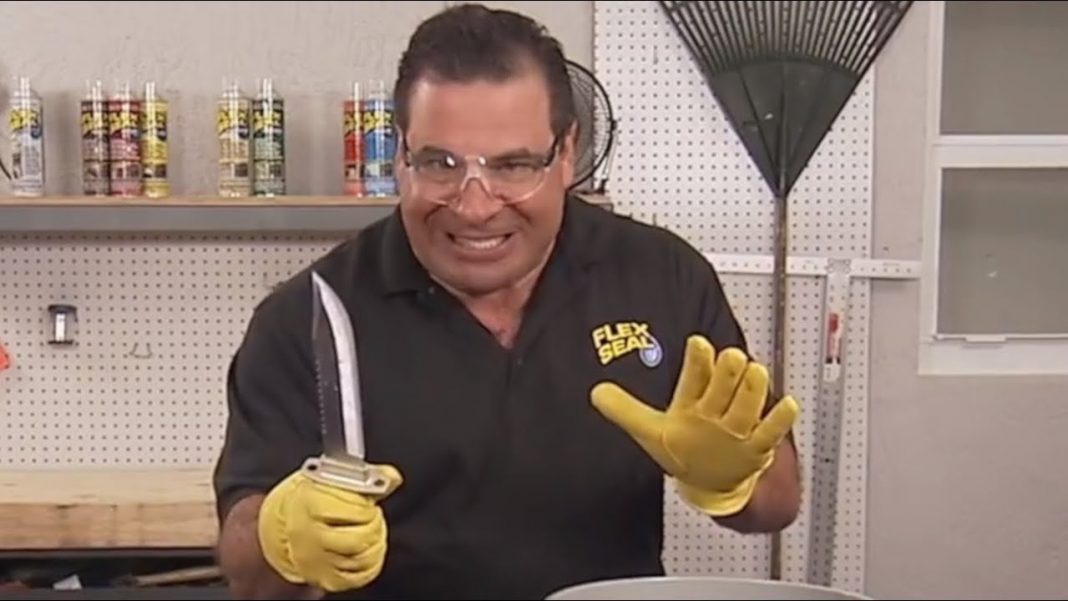If you watch a regional sportscast on TV, or some similar out-of-the-way cable fare, you’ll eventually see a commercial featuring a smiling, chubby man wearing casual clothes and speaking in a cheery piping voice. He is selling tape, glue, or goop that will mend anything you own. With the zeal of an old-time huckster, he touts the incredible strength of his products, staging increasingly bizarre demonstrations that climax with him steering a taped-together boat over shark-infested waters, or crashing a glue-assembled all-terrain vehicle through a rugged forest.
This man, your kids will inform you, is a cult figure, a folk hero, an Internet meme. But you’ve already figured this out from the deliberately cheesy, over-the-top energy of these ads. Before selling anything, they’re obviously meant to entertain, and the man with the big smile is the perfect fit for the job.
His appeal, as his youthful following suggests, is primarily ironic. You can’t miss the self-conscious wink in the broad delivery, the cartoon impact of the on-screen letters warning “Don’t Try This.” As our host attacks a plastic bucket with a hunting knife, then a chainsaw (“That’s a lotta damage!”), or shoots cannonballs through the bottom of one aluminum boat and splits another lengthwise with a blowtorch, the mayhem escalates to a blissful comic delirium. Like those ubiquitous spoofs of 1950s television shows, destroying stuff on camera is totally hilarious, regarded in a certain way. It’s the ideal spectacle for jaded, seen-it-all hipsters.
People in commercials who don’t have cell phones in their hands are becoming as rare a sight as college students walking around campus observing their surroundings.
But there’s another reason to love this affable pitchman. He offers a refreshing island of peace and relief. He interrupts a torrent of commercials for high-tech devices and services: cell phones, cell phone service providers, cars that pay attention for you so you can text and drive, home security devices that lock your doors and turn the thermostat down, robots that sit on your coffee table and answer your questions, robots that vacuum your floors. If it isn’t a high-tech device being advertised, then it’s how you can use your smartphone to deal more conveniently with the bank, the car dealer, the insurance company, the pizza place. People in commercials who don’t have cell phones in their hands are becoming as rare a sight as college students walking around campus observing their surroundings.
Amid this nonstop promotion of ever more complex, pervasive technology, we stumble across a nice man selling tape. He stands in a brightly lit, utilitarian space, surrounded by a few simple props. He offers recognizable products that anyone can use, products that allow you to repair things with your hands. You don’t need batteries, an instruction manual, a username, or an entry code. You don’t have to swipe anything, or go online to activate your tape or glue. It’s ready to go when you bring it home. It works in the rain, or underwater. It makes things stay stuck together for good. It won’t become obsolete.
Whether his fans actually purchase the man’s products or not, there’s no denying the genuine affection his patter inspires, or the subversive meaning his demonstrations imply. At some pre-ironic level, whether we acknowledge it or not, a persistent voice is calling us back. While a barrage of slick imagery commands “Update, upgrade, buy, replace,” this pleasant man advises us to fix what we have. Glue that rickety dining-room table back together. Plug that hole in your fishing boat. Fix the saddle on your grandmother’s rocking horse. Preserve the things you love, don’t throw them away. Bring together what’s broken. Make things whole. Live as if you value more than the next big thing, and care for the solid, handed-down life you have.












One might also add his products indeed work. (I won’t mention the brand name.) Two years ago we had a ceiling leak into our kitchen. I managed to pinpoint the approximate spot of the leak by searching around in the attic for wet spots. The first sunny day — to my wife’s horror — I was clambering up on the roof and gave the area a going-over with his transparent sealing spray. It’s been two Pennsylvania summers and winters since — and the roof remains tight as a drum. Few things in life are as satisfying as a do-it-yourself fix.
Comments are closed.